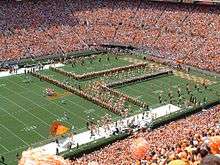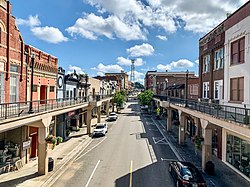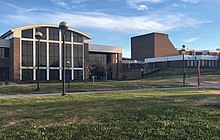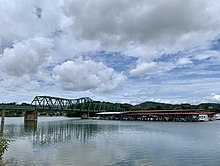Blaine, Tennessee
Blaine is a city in Grainger County, Tennessee, United States, and a suburb of the neighboring city of Knoxville.[7] It is part of both the Knoxville Metropolitan Statistical Area and the Morristown Metropolitan Statistical Area. The population was 1,856 at the 2010 census,[8] an increase of 271 individuals since the 2000 census.
Blaine, Tennessee | |
|---|---|
| City of Blaine | |
 Blaine City Hall and Library | |
 Seal | |
| Motto(s): "The City With Determination" | |
 Location of Blaine in Grainger County, Tennessee. | |
| Coordinates: 36°9′3″N 83°42′2″W | |
| Country | United States |
| State | Tennessee |
| County | Grainger |
| Incorporated | 1978 |
| Named for | Robert Blaine |
| Government | |
| • Type | Mayor-council |
| • Mayor | Marvin Braden |
| • Vice Mayor | Darrell Williams |
| • City Council | List of Councilmen
|
| Area | |
| • Total | 9.53 sq mi (24.69 km2) |
| • Land | 9.52 sq mi (24.65 km2) |
| • Water | 0.02 sq mi (0.05 km2) |
| Elevation | 961 ft (293 m) |
| Population | |
| • Total | 1,856 |
| • Estimate (2019)[4] | 1,860 |
| • Density | 195.46/sq mi (75.46/km2) |
| Time zone | UTC-5 (Eastern (EST)) |
| • Summer (DST) | UTC-4 (EDT) |
| ZIP code | 37709 |
| Area code(s) | 865 |
| FIPS code | 47-06340[5] |
| GNIS feature ID | 1269358[6] |
| U.S. Route | |
| Website | https://www.blainetn.gov/ |
History
Blaine was originally known as Blaine's Crossroads (sometimes spelled "Blain"). During the early 19th century, it was located at the intersection of several important roads,[9] and was the eastern terminus of the Emory Road, which traversed northern Knox County.[10] The community was likely named for Robert Blaine, who lived near the crossroads.[11] Shields' Station, a popular tavern and store, had been built in Blaine by the early 1830s. Blaine later served as a stop along the Knoxville and Bristol Railroad, also known as the Peavine Railroad, in the late 19th and early 20th centuries.[12]
In the late 19th to the early 20th century, Blaine was a stop on the Knoxville and Bristol Railroad, commonly known by locals as the "Peavine Railroad."[13] The line ran from the City of Morristown in Hamblen County, through the Richland Valley to the bedroom community of Corryton, north of Blaine.[13] With the creation of the railroad, Blaine saw a significant change from a small turnpike town, to a bustling railroad town.[13]
Geography
Blaine is located in the southwest corner of Grainger County at 36°9′3″N 83°42′2″W (36.150854, -83.700443).[14] It is situated around the intersection of U.S. Route 11W (Rutledge Pike), Tennessee State Route 61, and Indian Ridge Road. The city is southeast of the point where Grainger, Knox, and Union counties meet. Clinch Mountain and adjacent ridges rise prominently to the north and northeast, and House Mountain is visible to the southwest.
It is 14 miles (23 km) southwest of Rutledge, the county seat, 12 miles (19 km) southeast of Maynardville, and 19 miles (31 km) northeast of Knoxville. Blaine is connected to Knoxville and Rutledge via U.S. Route 11W and Maynardville via TN-61.
According to the United States Census Bureau, the city has a total area of 9.4 square miles (24.3 km2), all of it land.[8]
Demographics
| Historical population | |||
|---|---|---|---|
| Census | Pop. | %± | |
| 1980 | 1,147 | — | |
| 1990 | 1,326 | 15.6% | |
| 2000 | 1,585 | 19.5% | |
| 2010 | 1,856 | 17.1% | |
| Est. 2019 | 1,860 | [4] | 0.2% |
| Sources:[15][16] | |||
As of the census[5] of 2000, there were 1,585 people, 636 households, and 478 families residing in the town. The population density was 179.6 people per square mile (69.4/km2). There were 680 housing units at an average density of 77.1 per square mile (29.8/km2). The racial makeup of the town was 96.91% White, 1.07% African American, 0.32% Native American, 0.13% Asian, 0.63% from other races, and 0.95% from two or more races. Hispanic or Latino of any race were 1.01% of the population.
There were 636 households, out of which 31.4% had children under the age of 18 living with them, 60.2% were married couples living together, 10.4% had a female householder with no husband present, and 24.7% were non-families. 20.4% of all households were made up of individuals, and 5.2% had someone living alone who was 65 years of age or older. The average household size was 2.49 and the average family size was 2.87.
In the town, the population was spread out, with 22.5% under the age of 18, 9.5% from 18 to 24, 30.8% from 25 to 44, 26.4% from 45 to 64, and 10.8% who were 65 years of age or older. The median age was 37 years. For every 100 females, there were 95.2 males. For every 100 females age 18 and over, there were 95.2 males.
The median income for a household in the city was $30,677, and the median income for a family was $35,417. Males had a median income of $26,213 versus $20,707 for females. The per capita income for the city was $16,587. About 11.7% of families and 14.9% of the population were below the poverty line, including 19.9% of those under age 18 and 27.1% of those age 65 or over.
Economy
In its retail and commercial markets, Blaine has a small variety of restaurants, stores and professional services. A Food City supermarket is the only grocery store in Blaine.[17]
In 2007, the city received $520,560 in funding from the Economic Development Administration, and $867,600 towards developing the city's sewage treatment system for commercial and industrial sites.[18] The project created nearly 175 jobs in the city and the potential of $12.525 million in private investment.[18] In 2010, the Blaine City Council moved forward with the sewer project despite previous hurdles.[19]
Economic growth and development has appeared to make significant gains in the city after the construction of sewage treatment plant on the easternmost part of the city near the unincorporated community of Lea Springs.[20][21] Since the wastewater system project's completion in the early 2010s, Blaine has seen a massive boost in commercial development and population growth, both of which were contributed to the project, the planning of a business park site,[22] and the city's proximity to Knoxville appealing to commuters.[23][24]
Government
Municipal
Blaine uses the mayor-council system, which was established in 1978 when the city was incorporated. It is governed locally by a nine-member city council.[1]
The citizens elect the mayor and eight council members to four-year terms. The board elects a vice mayor from among the eight council members.
State
Blaine is represented in the 35th District of the Tennessee House of Representatives by Jerry Sexton, a Republican.[25]
It is represented in the 8th District of the Tennessee Senate by Frank Niceley, also a Republican.[26]
Federal
Blaine is represented in the United States House of Representatives by Republican Tim Burchett of the 2nd congressional district.[27]
References
- University of Tennessee, Municipal Technical Advisory Service. "Blaine". Municipal Technical Advisory Service. Retrieved July 28, 2020.
- "2019 U.S. Gazetteer Files". United States Census Bureau. Retrieved July 30, 2020.
- Tennessee Department of Economic and Community Development, Certified Population of Tennessee Incorporated Municipalities and Counties Archived 2014-06-30 at the Wayback Machine, State of Tennessee official website, 14 July 2011. Retrieved 6 December 2013.
- "Population and Housing Unit Estimates". United States Census Bureau. May 24, 2020. Retrieved May 27, 2020.
- "U.S. Census website". United States Census Bureau. Retrieved 2008-01-31.
- "US Board on Geographic Names". United States Geological Survey. 2007-10-25. Retrieved 2008-01-31.
- Collins, Kevin. "Grainger County". tennesseeencyclopedia.net. Retrieved February 9, 2020.
- "Geographic Identifiers: 2010 Demographic Profile Data (G001): Blaine town, Tennessee". American Factfinder. U.S. Census Bureau. Retrieved February 23, 2017.
- David H. Burr, "Map of Kentucky and Tennessee Exhibiting the Post Offices, Post Roads, Canals, Rail Roads, etc.," The American Atlas (J. Arrowsmith: 1839). Accessed at the Library of Congress American Memory Collection, 2015.
- Tennessee Historical Commission marker 1B8, "Emory Road." Accessed: 18 July 2015.
- Kevin Collins, "Grainger County," Tennessee Encyclopedia of History and Culture. Retrieved 21 July 2015.
- Carroll Van West, Tennessee's Historic Landscapes (University of Tennessee Press, 1995), p. 168.
- West, Carroll Van (1995). Tennessee's Historic Landscapes: A Traveler's Guide. University of Tennessee Press. pp. 166–167. ISBN 9780870498817.
- "US Gazetteer files: 2010, 2000, and 1990". United States Census Bureau. 2011-02-12. Retrieved 2011-04-23.
- "Census of Population and Housing: Decennial Censuses". United States Census Bureau. Retrieved 2012-03-04.
- "Incorporated Places and Minor Civil Divisions Datasets: Subcounty Resident Population Estimates: April 1, 2010 to July 1, 2012". Population Estimates. U.S. Census Bureau. Archived from the original on 17 June 2013. Retrieved 11 December 2013.
- City of Blaine, Tennessee. "City Businesses". blainetn.gov. Retrieved June 18, 2020.
- "Summary of EDA Investments". Economic Development Administration. Archived from the original on October 3, 2007. Retrieved August 11, 2020.
- Womack, Barbara (October 20, 2010). "Blaine crosses sewer hurdle". Grainger Today. Retrieved August 11, 2020.
- "Blaine to apply for sewer grant". Grainger Today. February 25, 2018. Retrieved June 18, 2020.
- City of Blaine, Tennessee. "AGREEMENT FOR OPERATIONS, MAINTENANCE AND MANAGEMENT SERVICES OF WASTEWATER SYSTEM" (PDF). mtas.tennessee.edu. Retrieved June 18, 2020.
- Flory, Josh (September 22, 2008). "Industrial sites under preparation". Knoxville News Sentinel.
- East Tennessee Economic Development Agency. "Blaine Business Park" (PDF). eteda.org. Retrieved June 18, 2020.
- Womack, Barbara (May 20, 2020). "Blaine FY 2020-21 budget passes first reading". Grainger Today. Retrieved June 18, 2020.
- "Representative Jerry Sexton". capitol.tn.gov. Retrieved June 25, 2020.
- "Senator Frank S. Niceley". capitol.tn.gov. Retrieved June 25, 2020.
- "Our District". Conrgessman Tim Burchett. Retrieved June 30, 2020.
External links
| Wikimedia Commons has media related to Blaine, Tennessee. |
- Official website
- Municipal Technical Advisory Service entry for Blaine — information on local government, elections, and link to charter




